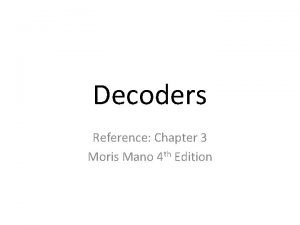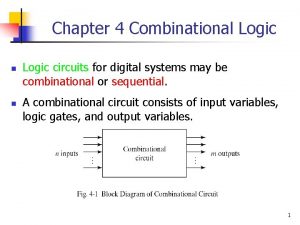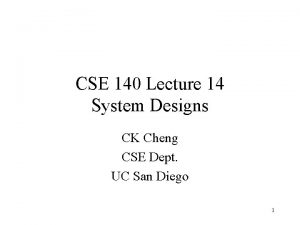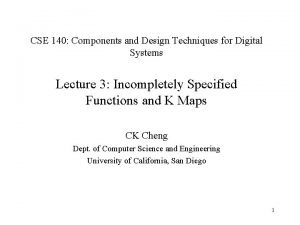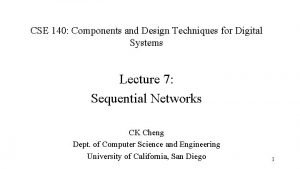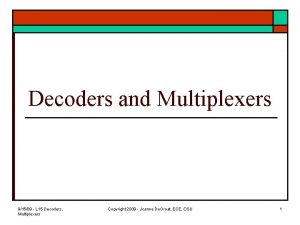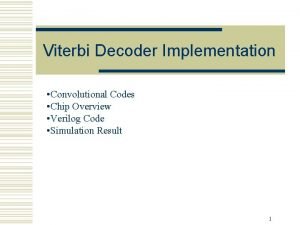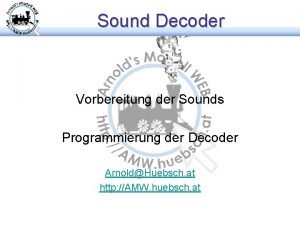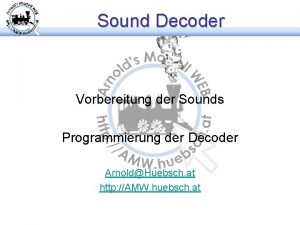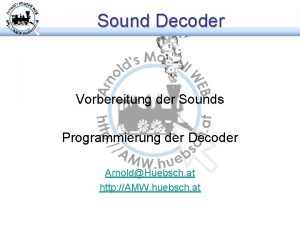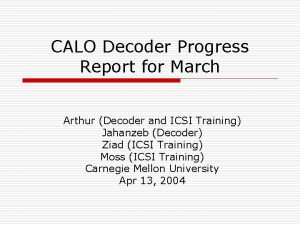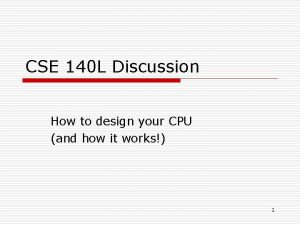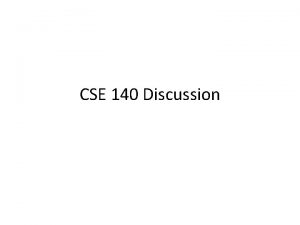CSE 140 Discussion Homework 4 Decoder Definition A
















- Slides: 16

CSE 140 Discussion Homework 4

Decoder Definition A digital module that converts a binary address to the assertion of the addressed device. E (enable) n inputs n= 3 I 0 0 I 1 1 I 2 2 0 1 2 3 4 5 6 7 y 0 y 1 . . 2 n outputs 2 3= 8 y 7 yi = 1 if E = 1 & (In, In-1, …, I 0 ) = i yi = 0, otherwise 2

Decoder Application • {Decoder, OR} is a universal set – Any Boolean function can be implemented with a set of decoders and OR gates. • If the function is described in the sum-ofproducts (minterms) form: – Decoder produces the minterms. – OR gate produces the sum from the minterms. – Ignore the don’t-cares. 3

Problem 1: Example Implement 3 -variable functions with a 3: 8 decoder and OR gates. i)f 1(a, b, c) = Σm(1, 2, 4) + Σd(0, 5), ii)f 2(a, b, c) = Σm(2, 3) + Σd(1, 4), iii)f 3(a, b, c) = Σm(0, 5, 6) y 1 y 2 y 4 E=1 c b a I 0 I 1 I 2 0 1 2 3 4 5 6 7 y 0. . y 7 f 1 y 2 y 3 f 2 y 0 y 5 y 6 f 3 4

What if the function has more than three variables? 4 variables: Implement a 4: 16 decoder using 3: 8 decoders. d c b I 0 I 1 I 2 a 0 1 2 3 4 5 6 7 y 0. y 7 y 8. y 15 5

What if the function has more than three variables? 6 variables: Implement a 6: 64 decoder using 3: 8 decoders. E I 2, I 1, I 0 I 5, I 4, I 3 I 2, I 1, I 0 … I 2, I 1, I 0 E D 0 D 1 y 0 y 7 y 8 y 15 … y 56 D 7 y 63 6

Encoder Definition A digital module that converts the assertion of a device to the binary address of the device. E 8 inputs 3 outputs I 0 Only one input can be asserted I 7 0 1 2 3 4 5 6 7 0 1 2 y 0 y 1 y 2 A (yn-1, . . , y 0 ) = I if E = 1 & one i s. t. Ii = 1 (yn-1, . . , y 0 ) = 0, otherwise. A = 1 if E = 1 & one i s. t. Ii = 1 A = 0, otherwise. 7

Priority Encoder E I 0 More than one input can be asserted 0 1 2 3 4 5 6 7 0 1 2 y 0 y 1 y 2 I 7 Eo Gs (yn-1, . . , y 0 ) = I if E = 1 & Ii = 1 & Ik = 0 for all k > i (yn-1, . . , y 0 ) = 0, otherwise. Eo = 1 if E = 1 & Ii = 0 for all i Gs = 1 if E = 1 & i s. t. Ii = 1 8 E

Problem 2: Example E I 31 -24 y 32, y 31, y 30 Eo Gs I 25 -16 y 22, y 21, y 20 Eo Gs I 15 -8 y 12, y 11, y 10 Eo Gs I 7 -0 y 02, y 01, y 00 Eo Gs 9

Multiplexer Definition A digital module that selects one of data inputs according to the binary address of the selector. E (Data input) D 2 n-1 -D 0 y Sn-1, 0 (Selector or Address) y = Di where i = (Sn-1, . . , S 0) if E = 1 y = 0, otherwise 10

Multiplexer Application • {Mux} is a universal set. – Any Boolean function can be implemented with a set of multiplexers. – Use Shannon’s expansion to decompose the function into smaller ones – simplify the decomposed functions using K-maps – Feed the smaller functions to data inputs of the mux and use the expansion variable as the selector. 11

Problem 3: Example Implement f (a, b, c) = Σm (0, 2, 6) + Σd(1) using an 8 -input Mux. id 0 1 2 abc 000 001 010 f 1 1 3 4 5 6 7 011 100 101 110 111 0 0 0 1 0 En 0 1 2 3 4 5 6 7 S 2 S 1 S 0 y a b c 12

What if the we have to use smaller muxes? Implement f (a, b, c) = Σm (0, 2, 6) + Σd(1) using an 4 -input Mux. E ab 00 01 10 c=0 1 1 0 c=1 0 0 D(c) D 0 = 1 D 1 = c’ D 2 = 0 11 1 0 D 3 = c’ 0 1 y 2 3 S 1 S 0 a b 13

What if the we have to use smaller muxes? Implement f (a, b, c) = Σm (0, 2, 6) + Σd(1) using an 2 -input Mux. E abc 0 1 0 01 0 10 1 1 11 0 0 D(b, c) D 0 D 1 0 y 1 a 14

What if the we have to use smaller muxes? Implement f (a, b, c) = Σm (0, 2, 6) + Σd(1) using an 2 -input Mux. abc 0 1 0 01 0 10 1 1 11 0 0 D(b, c) D 0 = c’ D 1 = bc’ E D 0 (b, c) = c’ c=0 c=1 1 1 0 b=1 D 1 (b, c) = bc’ c=0 c=1 0 0 b=1 D 0 0 D 1 1 y a 15

What if the we have to use smaller muxes? Implement f (a, b, c) = Σm (0, 2, 6) + Σd(1) using an 2 -input Mux. E D 1 (b, c) = bc’ bc 0 1 0 0 1 1 0 0 D(c) D 0 = 0 D 1 = c’ c’ E D 0 0 D 1 1 0 y 1 a b 16
 4 to 16 decoder using 2 to 4
4 to 16 decoder using 2 to 4 Quadruple 2 to 1 line multiplexer truth table
Quadruple 2 to 1 line multiplexer truth table Cse 140
Cse 140 Encoder definition
Encoder definition Cse 140
Cse 140 Cse 140
Cse 140 Fractional distillation conclusion
Fractional distillation conclusion Homework oh homework
Homework oh homework Homework oh homework i hate you you stink
Homework oh homework i hate you you stink Parts of a poem
Parts of a poem Oh homework oh homework poem
Oh homework oh homework poem Alitteration definition
Alitteration definition Literal language
Literal language Decoder definition
Decoder definition Gamet decoder
Gamet decoder Viterbi decoder verilog code
Viterbi decoder verilog code 5 to 32 decoder truth table
5 to 32 decoder truth table
